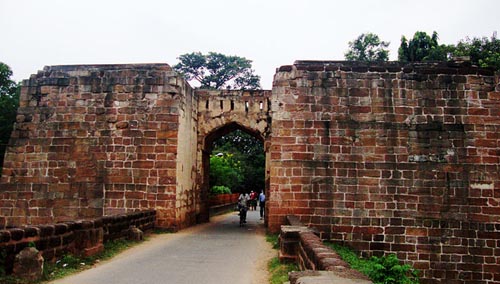Barabati Fort

Information on Barabati Fort (Cuttack, Odisha) - History & Architecture
The popular tourist sight of Cuttack, Orissa is the Barabati Fort, which attracts large number of tourist. The location of the Fort is about 8kms away from the main city of Cuttack, which is at the summit of the delta which has been formed by the Mahanadi River which is found in the north and to the south is its distributaries, the Kathajodi. The fort is at 14.62 meters from that of the sea level.
The fort was built by the Ganga dynasty, in the year 14th century. The fort today is found with the wreck, which is with the moat, gate and the mound of the palace which is approximately nine-stored palace. This ruin or the wreck is the parts which generates the past memories of its time.
Barabati Fort Architecture
The fort Barabati, is found with the square table and the fort has been extended to the total area of 102 acres and the entire of the fort has been surrounded or bordered by the stone paved moat, and this can be found on all the side of the fort. The construction of the moat around the fort comprises that of 10 meters to the northern and to that of the western side and to the eastern and the southern side is 20 meters.
There is a tank which is to be found on the west of the mound, and to the east-west is the carcass of the temple which was once situated at the corner of the mound. The temple was that of Lord Jagannath, and the structure of the temple was constructed with the white sandstone and the flooring foundation was done with the laterite blocks. So far, four hundred fragments of molding and the mutilated pieces of sculpture have been recovered.
There is also a mosque which still exists, in the fort which was built by Nawab Murshid Quil Khan, who was the governor of the Emperor Aurangzeb, in 1719 CE.
Barabati Fort History
The place Cuttack was found by the King Nrupa Keshari, in 989 AD. In 1006 AD, King Marakata Keshari constructed a strucutre of stone wall in order to prevent the city, Cuttack from the destruction to be made by the flood. As the King Anangabhima Dev 3 came to know about it, he shifted his capital to Abhinaba Varanasi Kataka, form Choudwar Kataka, and shortly in 1229 AD he constructed the Fort Barabati. The city, Cuttack has come under the supremacy of many dynasties, from the Kesharis to that of the Bhois, and to that basis the myth of the Cuttack city founder is attributed to Somacvansi King Nrupa Kesari. According to Madaslapanji, the fort was constructed in 989 AD, whereas the scholars like late professor P. Mukharjee sticks to the believe that the founder of the city Cuttack was that of the Ganga King Anangabhuimadeva 3 who was the ruler of the city from that of 1211 and ruled till 1238 AD.
Again in the year of 1560 AD the Chalukya king, MUkundadev Harichand, constructed the nine stored palace within the boundaries of the Barabati fort. In 1568 AD, The Hindu King of the Orissa, died while fighting against the Sultan of Bengal, Suleiman Karni. Again in the fifteenth and sixteenth century the fort Barabati, of Cuttack was protected by the two rings of fort. These two rings were to be found on the either side of the Kathajodi and the Mahanadi. The city Cuttack in 1568 AD, came under the dominance of Afgan rulers that of Bengal, and then was again under the dominance of the Moghul Empirer in 1592, and then in 1751 it came under the Marathas dominance. The whole of the Orissa, along with the Cuttack city came under the British rule in that of 1803. The city Cuttack, accomplished the thousand years of its continuation in 1989.
Barabati Fort Tourism Importance
The fort today is found next to that of Barabati Stadium, where several of sports events and activities take place and it is considered to be the venue, therefore while the visit the visit to the Barabati stadium the visitors can take a tour to the fort and have a momentary look at the fort, and the sculptures which is found. The religious people can also take a tour to the mosque, and acquire some blessings.
Though the temple, of the Lord Jagannath which is found close to the fort has been demolished or is on the carcass, still one can put their blessings as it is believed that the dwellings of the Lord or God can never be swept away. So, it's a worth visiting historical fort, but apart from this heritage structure, there are many others which is surely going to make a visit worth cherishing forever and ever. A visit of fort to savour history ends up with blessings of the Gods for prosperous and happy life.
- Andaman Nicobar Monuments
- Andhra Pradesh Monuments
- Assam Monuments
- Bihar Monuments
- Chhattisgarh Monuments
- New Delhi Monuments
- Goa Monuments
- Gujarat Monuments
- Haryana Monuments
- Himachal Pradesh Monuments
- Jammu and Kashmir Monuments
- Karnataka Monuments
- Kerala Monuments
- Madhya Pradesh Monuments
- Maharashtra Monuments
- Odisha Monuments
- Punjab Monuments
- Rajasthan Monuments
- Tamil Nadu Monuments
- Telangana Monuments
- Uttar Pradesh Monuments
- West Bengal Monuments